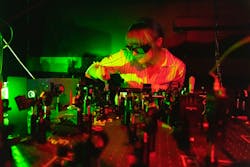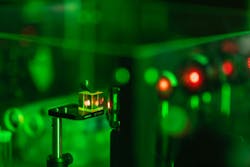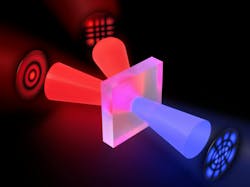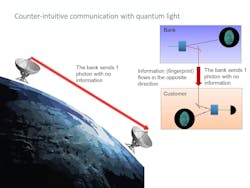If you crack open a quantum optics textbook, you’re likely to find a beamsplitter on every other page and could even go so far as to call it a quantum linear optics textbook. But a team of researchers from The University of the Witwatersrand (Wits) in South Africa and the Institute of Photonic Sciences (ICFO) in Spain just demonstrated quantum transport of patterns of light via nonlinear optics (see video).
It all started by wondering: what happens if you replace linear optics (see Fig. 1) with nonlinear optics? In the case of teleportation, it means you no longer need all of the extra photons. With just one entangled pair, the team created a high-dimensional teleportation approach.
The team’s approach is the first to show images can be transported across a network without physically sending the image—and it overcomes serious limitations posed by traditional quantum linear optics methods.
In their experimental demonstration, the researchers achieved quantum transport of high-dimensional states—and reported a new state-of-the-art 15 dimensions—using merely two entangled photons as a quantum resource, which “teleported” the information from a sender to a receiver. The secret sauce? A nonlinear optical detector outmaneuvers the need for more photons and works for any pattern you want to send. And perhaps the best part here is that their method is scalable to even higher dimensions, which opens the door to quantum network connections with high information capacity.
“Teleportation is a core requirement for quantum networks, but we knew from our past experience in teleporting two-dimensional states how difficult it would be to increase dimensions,” says Andrew Forbes, a distinguished professor in the School of Physics at Wits, who also established a laboratory for Structured Light there in 2015. “Two dimensions requires four entangled photons with very low count rates, and you need to keep adding pairs of entangled photons for each extra dimension—which is impossible.”
How does their nonlinear crystal method work?
The team uses a standard nonlinear crystal as their nonlinear optic (see Fig. 2), which they use as part of a detector. Two photons come in, combine, and produce one new photon via an upconversion process.
“Most entangled states are produced by a nonlinear crystal using a process known as spontaneous parametric down conversion (SPDC), where one photon comes in and two go out,” says Forbes. “But our nonlinear crystal detector does exactly the opposite—two in and one out, so we call it anti-SPDC. It turns out, anti-SPDC is all that’s needed to exactly teleport the state.”
Quantum communications over long distances is integral to the field of infosec and it’s already been demonstrated with two-dimensional states (qubits) between satellites. It may seem secure enough when compared to its classical counterpart, sending bits that can be enclosed in 1s (signal) and 0s (no signal), one at a time. But quantum optics goes a step further and enables researchers to increase the alphabet and securely describe more complex systems within a single shot, such as a unique fingerprint or a face.
Is it teleportation or quantum transport?
The team’s work opens the door to a completely new route to teleportation or quantum transport—and it overcomes the huge challenge of the traditional method that relies on linear optics, which will always require more photons.
“Our approach only needs two entangled photons but comes with an equally huge challenge: to truly be teleportation, nonlinear crystal efficiency must improve dramatically,” says Forbes. “We see our work as an exciting route with many open questions and challenges, including an opportunity for the metasurface community to contribute to very efficient nonlinearity for artificial materials.”
Their work also shines a spotlight on what exactly qualifies as true teleportation. “The debate is whether Alice, the person with the detector, must not know the state to be teleported or should not be able to know it,” says Forbes. “In our approach she could know it, but doesn’t need to. Is this truly teleportation? We think it is, but some disagree. To be safe, we call it quantum transport. One party can transport information to another without ever sending it. We think this is super cool and highly valuable for a quantum network.”
The concept of sending information to another person/party, say a bank, via light patterns without ever actually sending it is pretty astounding (see Fig. 3). “Say you want to send a fingerprint to a bank, and the bank sends you one photon with no information,” explains Forbes. “You overlap it with your fingerprint, and the result is that this information is transported to the bank immediately. Anyone who intercepts the bank’s photon gains nothing at all—since it contains no information. It’s amazing and only possible within the quantum world.”
Forbes admits seeing this experiment work was every bit as incredible as you’d expect, and although their method may sound simple it took years to get it to work.
Both Forbes and colleague Adam Vallés, of ICFO, applaud Bereneice Sephton, a postdoctoral research fellow at Wits, for getting the system to work and performing the key experiments.
What was the experience like for her? “It was elating—we had to move the lab in the middle of the experiment, so by the end we had changed, rechanged, and reworked the experimental setup so many times,” says Sephton. “So when the system was giving us the results, it was very rewarding.”
The coolest part for Sephton? “How well it worked in the end,” she says. “We were detecting photons very close to the noise floor in some instances, and the information made its way across splendidly! We also compared our ‘on the way’ results with the theoretical predictions to understand how to increase capacity, and it fit so well—like finally getting all of the pieces of a puzzle together. From then on, sending information in the opposite direction to where the photons were going is really counterintuitive, making it fun to play around with, both in principle and practice.”
Performing the proof-of-concept experiments with “currently available technology has been an interesting journey, and we have Dr. Sephton to thank for her determination and the comprehensive skillset needed to tame such an experimental beast,” says Vallés. “This is a true laboratory endeavor for which she should be lauded.”
This experiment was “hands-down the most difficult my group has ever done, and Bereneice did a fantastic job to make it work,” says Forbes. “Conceptually it’s very simple, but the implementation took years. She’s a rising star within our field, and it’s wonderful to see such talent.”
Nonlinear crystal efficiency in crosshairs
One challenge ahead is that nonlinear crystal efficiency must now increase dramatically for this to work in a way that the traditionalists would agree is true teleportation. “It’s a biggie, but very exciting because it draws in other communities beyond quantum—materials and metasurface scientists—to contribute to our global quantum network,” Forbes says.
Next up, the researchers are targeting higher dimensions—they’ve already shown up to 15—and down optical fiber, which “isn’t easy but is worth doing,” Forbes adds.
FURTHER READING
B. Sephton et al., Nat. Commun., 14, 8243 (2023); https://doi.org/10.1038/s41467-023-43949-x.
About the Author
Sally Cole Johnson
Editor in Chief
Sally Cole Johnson, Laser Focus World’s editor in chief, is a science and technology journalist who specializes in physics and semiconductors.




